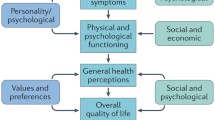Abstract
Objective: To report reference data for the heart-specific MacNew Heart Disease Health-Related Quality of Life instrument. Methods: One thousand five hundred and six patients with myocardial infarction (n = 346), heart failure (n = 201), and ischaemic heart disease (IHD, n = 959) were surveyed 4 months after hospital discharge. Quality of life scores were determined, stratified by diagnostic category, age and sex. Changes in scores from 4 to 8 months post-discharge were calculated for a subset of 830 patients, stratified by age and sex. Results: At 4 months there were no significant differences in scores between myocardial infarction and electively admitted IHD patients, however the scores of heart failure patients were significantly lower (indicating poorer quality of life) than those of patients with other diagnoses. There were few significant differences between age groups or sexes when comparing within diagnostic groups. Change from 4 to 8 months was not associated with diagnosis, age, or sex but was associated with events within the period (readmission or revascularisation). The change data suggest that a value of 0.5 may be a useful indicator of the minimal clinically important difference. Conclusions: These reference data will assist in sample size calculations and with comparison of results in other studies, and will be of use to researchers who are using or intending to use the MacNew instrument.
Similar content being viewed by others
References
Hillers TK, Guyatt GH, Oldridge N, et al. Quality oflif e after myocardial infarction. J Clin Epidemiol 1994; 47(11): 1287–1296.
Lim LL-Y, Valenti LA, Knapp JC, et al. A self-administered quality of life questionnaire after acute myocardial infarction. J Clin Epidemiol 1993; 46(11): 1249–1256.
Valenti L, Lim L, Heller RF, Knapp J. An improved questionnaire for assessing quality of life after acute myocardial infarction. Qual Life Res 1996; 5: 151–161.
Oldridge N, Guyatt G, Jones N, et al. Effects on quality of life with comprehensive rehabilitation after acute myocardial infarction. Am J Cardiol 1991; 67: 1084–1089.
Dixon T, Lim LL-Y, Powell H, Fisher JD. Psychosocial experiences ofcardiac patients in early recovery: A community-based study. J Adv Nurs 2000; 31(6): 1368–1375.
Lim LL-Y, Johnson NA, O'Connell RL, Heller RF. Quality oflif e and later adverse health outcomes in patients with suspected heart attack. A NZ J Public Health 1998; 22(5): 540–546.
Foster C, Oldridge NB, Dion W, et al. Time course ofrecovery during cardiac rehabilitation. J Cardiopulmonary Rehabil 1995; 15: 209–215.
Community and Health Services Tasmania. ICD-9-CM International Classification of Diseases, 9th ed. Clinical Modification, vol.1. Hobart, Tasmania: Department of Community and Health Services, 1992.
Juniper EF, Guyatt GH, Willan A, Griffith LE. Determining a minimal important change in a disease-specific quality oflif e questionnaire. J Clin Epidemiol 1994; 47(1): 81–87.
Asch DA, Jedrziewski MK, Christakis NA. Response rates to mail surveys published in medical journals. J Clin Epidemiol 1997; 50(10): 1129–1136.
Author information
Authors and Affiliations
Rights and permissions
About this article
Cite this article
Dixon, T., Lim, L.LY. & Oldridge, N.B. The MacNew heart disease health-related quality of life instrument: Reference data for users. Qual Life Res 11, 173–183 (2002). https://doi.org/10.1023/A:1015005109731
Issue Date:
DOI: https://doi.org/10.1023/A:1015005109731




